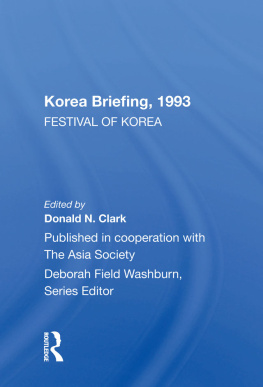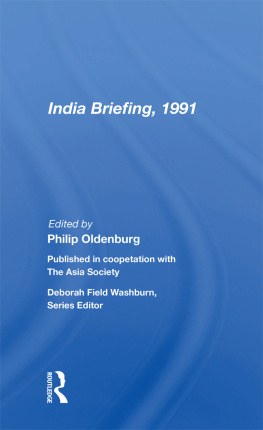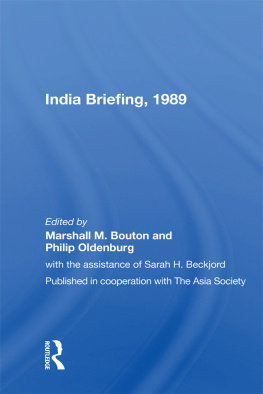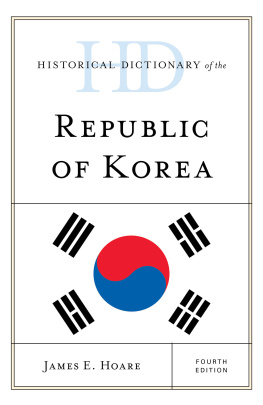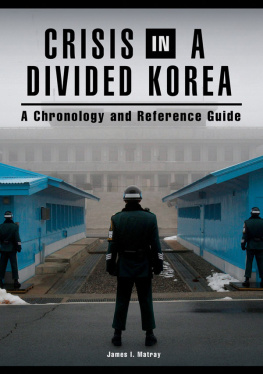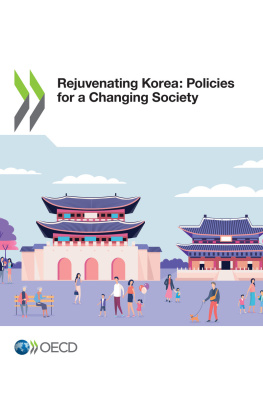Korea Briefing, 1990
First published 1991 by Westview Press
Published 2018 by Routledge
52 Vanderbilt Avenue, New York, NY 10017
2 Park Square, Milton Park, Abingdon, Oxon OX14 4RN
Routledge is an imprint of the Taylor & Francis Group, an informa business
Copyright 1991 by The Asia Society
All rights reserved. No part of this book may be reprinted or reproduced or utilised in any form or by any electronic, mechanical, or other means, now known or hereafter invented, including photocopying and recording, or in any information storage or retrieval system, without permission in writing from the publishers.
Notice:
Product or corporate names may be trademarks or registered trademarks, and are used only for identification and explanation without intent to infringe.
Library of Congress ISSN: 1053-4806
ISBN 0-8133-8009-X
ISBN 0-8133-8010-3 (pbk.)
ISBN 13: 978-0-367-01555-8 (hbk)
Contents
CHONG-SIK LEE
SUNG-JOO HAN
BYUNG-JOON AHN
CHONG-SIK LEE
BON-HO KOO
VINCENT S. R. BRANDT
SEONG-KON KIM
MICHAEL C. KALTON
Guide
The Asia Society is pleased to introduce this first volume of Korea Briefing, an annual review of domestic and international trends and events in the Republic of Korea. Korea Briefing follows upon two other annual reviews published by the Society, China Briefing, begun in 1980, and India Briefing, which recently published its fourth volume. All three books are copublished by The Asia Society and Westview Press. The Asia Society is a nonprofit, nonpartisan educational organization dedicated to increasing understanding by Americans of Asia and its importance to the United States and the world at large.
Public and scholarly interest in Korea is higher than ever today in the United States. A take-off in Korean studies and public education about Korea has occurred. The Asia Society has played an active part in fostering this new interest. In addition to Korea Briefing and other publications, the Society sponsors policy studies and public education programs relating to this very important part of Asia.
As this book goes to press, the South and North Korean prime ministers have just met in Seoul at a high level, and a second meeting, in Pyongyang, is imminent. No one can suppose a quick solution to deep-seated issues that still generate high levels of tension. Yet the events of the world continue to surprise us, suggesting that not even strategic arrangements are permanent. In the meantime, South Koreas economy is projected to grow at an annual rate of more than 9 percent in 1990, a respectable advance over the 1989 level. Its experiment in democracy continues to take hold. The nation plays new roles in world affairs. These and other themes are treated in depth in the chapters that follow.
I wish to thank Professor Chong-Sik Lee for commissioning and critiquing the chapters and to express my appreciation to him and the other six authors for their fine job of chapter preparation and revision. The Society is grateful to Susan McEachern and her colleagues at Westview Press for their support of the new series.
Several individuals played significant roles in the preparation of this volume. Asia Society Senior Editor Deborah Field Washburn and Publications Assistant Andrea Sokerka guided the book through the editorial and production processes. Program Associate Scott Snyder provided excellent substantive assistance on particular chapters. Dawn Lawsons editorial skills improved the book enormously. Sung-Jae Oh diligently compiled the chronology and glossary. Special thanks are due to Assistant Director Sherrill M. Davis, who worked closely with the editor and chapter authors from the outset, bringing to this project her own commitment to public education and Korean studies.
K. A. Namkung
Executive Director
Education and Contemporary Affairs Division
The Asia Society
September 1990
Copyright 1990 Asia Society
Chong-Sik Lee
We are living in an era of momentous changes. Almost daily we hear about developments that were unthinkable a few years ago. The leaders of the worlds seven major industrial nations, for example, met in Houston in July 1990 to discuss the ways and means of providing economic aid to the Soviet Union. The Soviet Union, in turn, agreed not to oppose membership of a united Germany in NATO. East and West Germany have just reunited completely. No one would have predicted these events even a year ago. There is no doubt now that, as far as Europe is concerned, the cold war has ended.
The changes on the Korean peninsula may not have been as dramatic, but many of the events that occurred between 1988 and 1990 can be characterized as historic in the context of Koreas sociopolitical development. The most obvious change was in South Koreas relations with what used to be called the socialist camp. South Korea established diplomatic relations with all the East European nations (except Albania) in 1989 and early 1990; with the establishment of an official relationship with the Soviet Union in September 1990, South Koreas foreign relations entered a new era.
These developments, of course, affected North Korea, because the Soviet Union and the East European nations had been North Koreas staunch allies since the Democratic Peoples Republic of Korea (DPRK) was established in 1948. North Korea sharply protested the East European and Soviet rapprochement with South Korea, but in vain. These countries wanted to pursue their own interests rather than follow the dictates of Pyongyang.
Significant changes occurred within South Korea as well. The dismantling of the military-imposed political system in 1987 and the inauguration of Roh Tae Woo as president of the Republic of Korea (ROK) in 1988 marked the beginning of a new era in South Koreas political history. Although one cannot dismiss the militarys potential as a political force in South Korea, it no longer plays the dominant role it once did. While not all legal taboos and restrictions have been lifted, the new political system allows the South Korean people the greatest degree of freedom ever in Korean history. Even though there were irregularities in the presidential elections in 1987 and the National Assembly elections the following year, there is no doubt that the voters exercised their rights. The National Assembly is no longer a rubber stamp, and the president can no longer act on his own as his predecessors did for nearly four decades. In short, South Korea underwent its own version of political perestroika. These are the subjects of chapters by Sung-Joo Han (politics) and Byung-Joon Ahn (international relations).
South Koreas relations with North Korea have been slow to change, but much has happened recently on this front as well. Chong-Sik Lees chapter shows that North and South Korea held more meetings and exchanged more communication during 1989 than ever before. Not much happened during the first half of 1990, but in July the two sides agreed to hold a meeting of prime ministers in Seoul in September, to be followed by a similar meeting in Pyongyang in October. Although the Seoul meeting did not go beyond setting an agenda, it represented a major landmark in North-South relations, and there are high hopes that the meeting in Pyongyang will be productive.
The sudden removal of political restrictions greatly affected South Koreas society and economy, as the chapters by Vincent Brandt (society) and Bon-Ho Koo (economy) describe. The students, who had been vociferous even under the draconian regime of Chun Doo Hwan, demanded vast reforms. The workers, whose rights and interests had been restricted, if not suppressed, by the previous regimes, demanded their fair share. Demonstrations and strikes became the norm in South Korea in 1989. Interests and emotions clashed in the open. Manufacturers could not deliver the goods promised, and foreign buyers stayed away. Wages rose, and South Korea lost its competitive edge against other developing economies. Korean economists, however, predict that South Koreas economy will rebound in the latter half of 1990, with a 9.5 percent rise in GNP.



